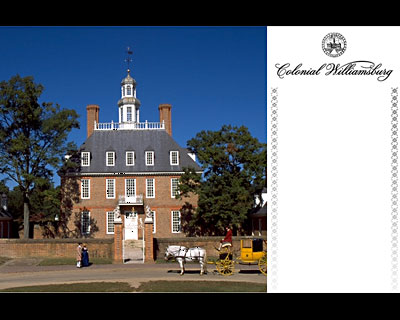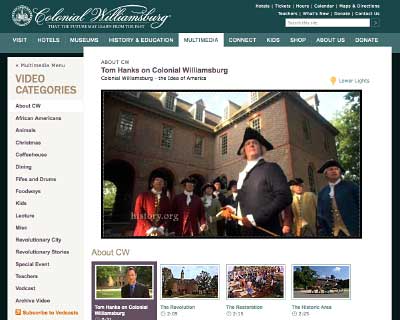Page content
September 7, 2010
Colonial Williamsburg Foundation and Preservation Virginia Collaborate to Enhance Archaeology and Expand Guest Experience
A new collaboration between The Colonial Williamsburg Foundation and Preservation Virginia will showcase the connected histories of Jamestown and Williamsburg through compelling stories of discovery, diversity and democracy. The initiative will bring together experts from Historic Jamestowne and Colonial Williamsburg to enhance public archaeology and create a broader, more cohesive guest experience through family-friendly programs. Additionally, to increase national and international recognition of the region’s unparalleled historical and cultural resources, Colonial Williamsburg and Preservation Virginia, with the assistance of the National Park Service, will collaborate to seek designation of the Historic Triangle as a World Heritage Site.
“At the heart of this exciting collaboration is support for public archaeology,” said Colin Campbell, president and CEO of The Colonial Williamsburg Foundation. “The continuing practice of archaeology at Jamestown and Williamsburg demonstrates the outstanding historical resources and importance of these original sites. The work envisioned over the next five years will build on Colonial Williamsburg’s and Preservation Virginia’s distinguished record of achievement in the field and is a natural follow-on to the activities of the 400th Anniversary of Jamestown.”
The collaboration continues a legacy of cooperative achievements between the two organizations. “The Board of Preservation Virginia enthusiastically welcomes this opportunity to pursue continued efforts with The Colonial Williamsburg Foundation,” said John H. Guy, IV, president of Preservation Virginia. “This exploration reignites the cooperative endeavors that have characterized the history of our organizations. From the 1920s at the inception of The Colonial Williamsburg Foundation through our recent work together toward 2007 and the Jamestown anniversary, a collaborative spirit has enabled both organizations to achieve our missions and our stewardship obligations. Preservation Virginia looks forward to this opportunity to elevate awareness of our archaeological research at Historic Jamestowne within the context of the Historic Triangle.”
Collaboration is a central element of Preservation Virginia’s vision for the future. “Working collaboratively on shared educational and program objectives is one of the most effective tools we have to ensure that Virginia’s historic places are preserved and interpreted and provide community benefit for years to come,” said Elizabeth S. Kostelny, executive director of Preservation Virginia. “Preservation Virginia acknowledged this tool in our strategic planning as a way to deploy resources efficiently. At Historic Jamestowne, this effort will support our long-held goals for the archaeological research project and disseminate those findings. Coupled with our 70 plus year partnership with the National Park Service, this expanded model will have positive benefits locally and provide a sustainable example for other localities across the Commonwealth and nation.”
The combined effort will underscore the importance of the region to the emergence of the United States. The Historic Triangle, comprised of Jamestown, Williamsburg and Yorktown, is one of the foundations of America. Jamestown is the site of the first permanent English settlement in the New World and witness to the first sustained encounters between the English, Indians and Africans. Williamsburg is where the seminal democratic principles of an independent new nation were debated and forged. At Yorktown, British troops surrendered to combined American and French forces on October 19, 1781, effectively ending the American Revolution and significantly changing the course of world history.
“This initiative is timely and necessary,” said Campbell. “Americans today are less well informed about the nation’s history than their counterparts of a generation ago, and there has been a steady erosion of history education in our schools. The combination of Historic Jamestowne’s emphasis on early English America with Colonial Williamsburg’s presentation of the Revolutionary period will provide a coherent and compelling narrative of the nation’s founding.”
The collaboration will highlight America’s colonial development as well as its revolutionary heritage. “Through Jamestown’s and Williamsburg’s rich historical legacy we will highlight ongoing archaeological fieldwork, museum collections and related interpretive programs both on site and online,” said Jim Horn, Colonial Williamsburg’s vice president for research and historical interpretation and the Abby and George O’Neill Director of the John D. Rockefeller Jr. Library. “Who we are as a people, the nature of our democracy and the rights and responsibilities of citizens will be the focus of stories within the overarching themes of discovery, diversity and democracy.” Colonial Williamsburg, through Horn, will assume responsibility for programs and operations at Historic Jamestowne for Preservation Virginia.
Archaeological discoveries and on site interpretation will be further enhanced. “More formally developing the Historic Triangle concept with Colonial Williamsburg places Preservation Virginia’s recent archaeological revelation of 1607 Jamestown into a greater ‘birth of the nation’ context,” said William M. Kelso, director of archaeological research and interpretation for Preservation Virginia. “This alliance will immeasurably enhance the research and presentation of the first permanent English colony site by more clearly explaining how the traditions that began there evolved into the American struggle for independence.”
The collaboration will leverage resources to strengthen respective educational missions, program development and marketing initiatives. Colonial Williamsburg will provide additional marketing and fund-raising resources to stimulate public awareness of and increased support for Historic Jamestowne.
Colonial Williamsburg and Preservation Virginia also will lead an effort seeking designation of the Historic Triangle as a World Heritage Site. Twenty sites in the United States are recognized as World Heritage Sites, but none relate specifically to the establishment of English society in America, the first contact with Indian peoples, the arrival of the first Africans, the evolution of democratic ideas and institutions in early America, the survival of an entire 18th-century town as the capital of the largest colony and original state, the first articulation of a Declaration of Rights and principles of religious freedom and the winning of the American Revolution.
Background: Discovery, Diversity and Democracy
Connecting the themes of discovery, diversity and democracy at Historic Jamestowne and Williamsburg will create a memorable and profound visitor experience.
“We want to put the visitor at the point of discovery at the moment archaeologists uncover artifacts lost in the ground for centuries,” said Horn. “The entire process of excavation, identification, conservation, interpretation and dissemination is made transparent and exciting to the viewing public.”
Discovery
Diversity
Democracy
The Colonial Williamsburg Foundation is the not-for-profit educational institution dedicated to the preservation, interpretation and presentation of the restored 18th-century Revolutionary capital of Virginia. This town-sized living history museum tells the inspirational stories of our journey to become Americans through programs in the Historic Area and through the award-winning Revolutionary City program. Explore the Art Museums of Colonial Williamsburg and discover the DeWitt Wallace Decorative Arts Museum featuring British and American decorative arts from 1670–1830 and the Abby Aldrich Rockefeller Folk Art Museum home to the nation’s premier collection of American folk art, comprising more than 5,000 folk art objects from the 18th, 19th and 20th centuries. Colonial Williamsburg is committed to expanding its thought-provoking programming through education outreach on-site and online. For more information about Colonial Williamsburg, call 1-800-HISTORY or visit Colonial Williamsburg’s website at www.history.org.
Preservation Virginia, a private non-profit organization and statewide historic preservation leader founded in 1889, is dedicated to perpetuating and revitalizing Virginia's cultural, architectural and historic heritage thereby ensuring that historic places are integral parts of the lives of present and future generations. Its mission is directly consistent with and supportive of Article XI of the Constitution of Virginia to protect the historical sites and buildings in the Commonwealth benefiting both the Commonwealth and the nation. Preservation Virginia provides leadership, experience, influence and services to the public and special audiences by saving, managing, and protecting historic places, and developing preservation policy, programs, and strategies with individuals, organizations, and local, state, and national partners. www.preservationvirginia.org
Historic Jamestowne is jointly administered by Preservation Virginia and the National Park Service and preserves the original site of the first permanent English settlement in the New World. Visitors share the moment of discovery with archaeologists and witness archaeology-in-action at the 1607 James Fort excavation April-October; learn about the Jamestown Rediscovery excavation at the Nathalie P. and Alan M. Voorhees Archaearium, the site's archaeology museum; tour the original 17th-century church tower and reconstructed 17th-century Jamestown Memorial Church; and take a walking tour with a Park Ranger through the New Towne area along the scenic James River. For further information, visit www.HistoricJamestowne.org or call (757) 229-0412 or (757) 229-1733.
In 1893 Preservation Virginia acquired 22.5 acres of Jamestown Island. In 1930 Colonial National Monument was established to include Jamestown, Yorktown and the Colonial Parkway to connect sites marking the beginning and end of the British experience in colonial America. The National Park Service acquired the rest of the 1,500 acre island in 1934 and jointly administers Historic Jamestowne with Preservation Virginia. Today Colonial National Historical Park preserves some 8,600 acres, including the Cape Henry Memorial, site of the first landing of Jamestown’s colonists. http://www.nps.gov/colo/
Media Contact:
Tom Shrout
(757) 220-7265




